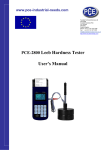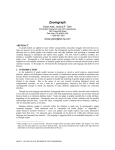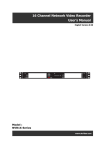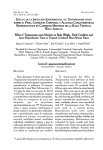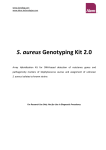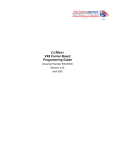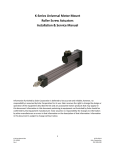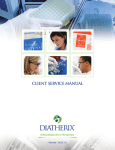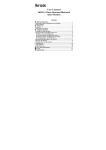Download the Package Insert
Transcript
44429999 P0153(01)) 2013-122 For IIn Vitro Diaggnostic Use For uuse with thee BD MAX™ ™ System Rx O Only (USA A) INTTENDED USE The BD MAX™ ™ StaphSR R assay peerformed oon the BD MAX™ Syystem is ann automateed qualitattive in vitroo diaggnostic testt for the direct detecction and ddifferentiation of Stapphylococcuus aureus (SA) and methicillin-resisstant Staphhylococcuss aureus (M MRSA) DN NA from naasal swabss in patientts at risk foor nasal coolonization.. The test utilizees real-tim me polymerrase chain reaction ((PCR) for the ampliffication of MRSA/SA A DNA andd fluorrogenic tarrget-specific hybridizzation probbes for thee detectionn of the am mplified DN NA. The B BD MAX™ ™ StapphSR assaay is intendded to aid in the prevvention and control oof MRSA aand SA infeections in healthcaree settings. It is nnot intendedd to diagnoose MRSA A or SA infeections norr guide or m monitor treaatment for MRSA/SA A mitant culturres are neecessary too infecctions. A nnegative reesult does not precludde nasal ccolonizationn. Concom recoover organisms for eppidemiologiical typing or for furthher suscepttibility testinng. SUM MMARY A AND EXP PLANATION OF TTHE PRO OCEDURE S. aaureus is a major caause of noosocomial infections such as bloodstreaam infectioons and suurgical sitee infecctions with clinical manifestations rangingg from pusttules to seepsis and ddeath1. It iss commonly found inn the nose or onn the skin of healthyy individualls (asympttomatic carrriers). Treeatment of S. aureuss infectionss has become a real challlenge with the emerggence of sstrains resistant to prreviously eeffective anntimicrobiall agennts. Methiccillin-resistaant strainss of S. aurreus are frrequently eencountereed in healtth-care setttings, andd represent nearrly 60% of isolates frrom hospitaal-acquiredd S. aureuss in some North Ameerican and Europeann MRSA mayy be transm mitted from m patient too patient thhrough thee heallthcare faccilities2,3. Inn hospital ssettings, M conttaminated hands of hhealthcare workers. R Risk factors for colonnization witth MRSA inn healthcare settingss incluude prolonnged hospital stay, proximity to patientss infected with MRS SA, expossure to muultiple andd proloonged brooad-spectruum antibiottic treatmeents, and MRSA carriage. M MRSA infecction is inccreased inn patieents colonized with M MRSA. SSI) 2,4. It iss responsibble for 20% % to 56% off S. aureus is onne of the leeading causses of surggical site innfections (S 4 which MRS SA represeents up too 57% of isolates . The mortaality rate aassociated with bothh SSI,, among w %4,5. In moost patients with SS SI, the S.. aureus iinfection iss from ann pathhogens varies from 5 to 22% 4,6 endoogenous soource . RSA requirre culture ssteps and iisolation off Tradditional techniques ussed for thee detection of S. aureeus and MR puree colonies, followed bby agglutinaation testinng to identiffy S. aureuus and eitheer oxacillinn susceptibbility testingg, deteection of the mecA geene for methicillin ressistance, orr detectionn of the pennicillin bindding proteinn (PBP 2a)) to iddentify MRS SA. A minimum of 244 hours arre requiredd to resolvee the S. auureus and MRSA staatus, with a meddian time off more thann 48 hours, when using these cconventionaal methodss. mortality aassociated with S. auureus infecctions, the emergence of mecA A Withh the increased morbbidity and m dropp-out strainns and thee spreadingg of a new w methicillin resistancce gene (ii.e., mecC gene), thee ability too deteect and diffeerentiate S S. aureus aand MRSA within houurs instead of day(s) rrepresents a definite advantagee overr current prractices annd allows foor more efffective patieent treatmeent and maanagementt. P01553(01) 1 A nasal specimen is collected and transported to the laboratory using the recommended swab (refer to “Equipment and Materials Required But Not Provided” section). The swab is placed in a BD MAX™ StaphSR Sample Buffer Tube. The Sample Buffer Tube is vortexed to release cells from the swab into the buffer. The Sample Buffer Tube is placed into the BD MAX™ System and the following automated procedures occur: the bacterial cells are lysed; DNA is extracted on magnetic beads and concentrated; and then an aliquot of the eluted DNA is added to PCR reagents which contain the SA- and MRSA-specific primers used to amplify the genetic targets, if present. The assay also includes a Sample Processing Control (SPC). The SPC is present in the Extraction Tube and undergoes the extraction, concentration and amplification steps to monitor for inhibitory substances as well as process inefficiency due to instrument or reagent failure. No operator intervention is necessary once the clinical sample and reagent strip are loaded into the BD MAX™ System. The BD MAX™ System automates sample lysis, DNA extraction and concentration, reagent rehydration, nucleic acid amplification and detection of the target nucleic acid sequence using real-time polymerase chain reaction (PCR). Amplified targets are detected with hydrolysis probes labeled with quenched fluorophores. The amplification, detection and interpretation of the signals are done automatically by the BD MAX™ System. PRINCIPLES OF THE PROCEDURE The BD MAX™ System uses a combination of lytic and extraction reagents to perform cell lysis and DNA extraction. Following enzymatic cell lysis at elevated temperature, the released nucleic acids are captured by magnetic affinity beads. The beads with the bound nucleic acids are washed and the nucleic acids are eluted by heat in Elution Buffer. Eluted DNA is neutralized with Neutralization Buffer and transferred to the Master Mix Tube to rehydrate the PCR reagents. The reconstituted amplification reagent is dispensed into the BD MAX™ PCR Cartridge. Microvalves in the BD MAX™ PCR Cartridge are sealed by the system prior to initiating PCR to prevent evaporation and amplicon contamination. The amplified DNA targets are detected using hydrolysis (TaqMan®*) probes labeled at one end with a fluorescent reporter dye (fluorophore) and at the other end with a quencher moiety. Probes labeled with different fluorophores are used to detect a specific amplicon in the SCCmec right-extremity junction (MREJ), the genes for methicillin resistance mecA and mecC, the nuc gene encoding a thermostable nuclease of S. aureus and SPC amplicons in four different optical channels of the BD MAX™ System: MREJ amplicons are detected in the FAM channel, mecA and mecC amplicons are detected in the ROX channel, nuc amplicons are detected in the VIC channel and SPC amplicons are detected in the Cy5.5 channel. When the probes are in their native state, the fluorescence of the fluorophore is quenched due to its proximity to the quencher. However, in the presence of target DNA, the probes hybridize to their complementary sequences and are hydrolyzed by the 5’-3’ exonuclease activity of the DNA polymerase as it synthesizes the nascent strand along the DNA template. As a result, the fluorophores are separated from the quencher molecules and fluorescence is emitted. The amount of fluorescence detected in the four optical channels used for the BD MAX™ StaphSR assay is directly proportional to the quantity of the corresponding probe that is hydrolyzed. The BD MAX™ System measures these signals at the end of each amplification cycle, and interprets the data to provide a result. REAGENTS REF Contents BD MAX™ StaphSR Master Mix (B7) Dried PCR Master Mix containing polymerase, nucleotides and specific molecular probes and primers along with Sample Processing Control-specific molecular probe. BD MAX™ StaphSR Reagent Strip Unitized Reagent strip containing all liquid reagents and disposable pipette tips 442999 necessary for specimen processing and DNA extraction. BD MAX™ StaphSR Extraction Tube (B8) Dried extraction reagent containing DNA magnetic affinity beads, Achromopeptidase and Sample Processing Control BD MAX™ StaphSR Sample Buffer Tube (with 25 septum caps) 2 Quantity 24 tests 24 tests 24 tests 24 tests EQUIPMENT AND MATERIALS REQUIRED BUT NOT PROVIDED BBL™ CultureSwab™ Liquid Stuart single or double swab (BD catalog no. 220099 or 220109), Copan (Venturi) Transystem®* Liquid Stuart single or double swab (Copan, catalog no. 141C or 139C) VWR Multi-Tube Vortexer (VWR catalog no. 58816-115) NALGENE®* Cryogenic Vial Holder (VWR, catalog no. 66008-783) Disposable gloves, powderless Sterile scissors (optional) Sterile Gauze Stopwatch or timer BD MAX™ PCR Cartridges (BD catalog no. 437519) WARNINGS AND PRECAUTIONS For in vitro diagnostic use. Do not use the kit if the label that seals the outer box is broken. Do not use reagents if the protective pouches are open or torn upon arrival. Close reagent protective pouches promptly with the zip seal after each use. Remove any excess air in the pouches prior to sealing. Do not remove desiccant from reagent pouches. Check reagent strips for proper liquid fills (ensure that the liquids are at the bottom of the tubes) (see Figure 1). Check reagent strips to ensure that all pipette tips are present (see Figure 1). Do not use reagents if desiccant is not present or broken inside reagent pouches. Do not use reagents if the foil has been opened or damaged. Do not mix reagents from different pouches and/or kits and/or lots. Do not use expired reagents and/or materials. Do not mix caps between tubes or re-use caps as contamination may occur and compromise test results. Proceed with caution when using chemical solutions as Master Mix and Extraction tube barcode readability may be altered. To avoid contamination of the environment with SA or MRSA amplicons, do not break apart the BD MAX™ PCR Cartridge after use. The seals in the BD MAX™ PCR Cartridges prevent contamination. The laboratory should routinely perform environmental monitoring to minimize the risk of crosscontamination. Performing the assay outside of the recommended time ranges may produce invalid results. Assays not performed within specified time ranges should be repeated. Additional controls may be tested according to guidelines or requirements of local, state, provincial and/or federal regulations or accrediting organizations. In cases where culture or other PCR tests are conducted in the same general area of the laboratory, care must be taken to ensure that the BD MAX™ StaphSR assay, any additional reagents required for testing, and the BD MAX™ System are not contaminated. Gloves must be changed before manipulating reagents and cartridges. Always handle specimens as if they are infectious and in accordance with safe laboratory procedures such as those described in CLSI Document M297 and in Biosafety in Microbiological and Biomedical Laboratories8. Wear protective clothing and disposable gloves while handling kit reagents. Wash hands thoroughly after performing the test. Do not pipette by mouth. Do not smoke, drink, or eat in areas where specimens or kit reagents are being handled. Dispose of unused reagents and waste in accordance with country, federal, provincial, state and local regulations. STORAGE AND STABILITY Collected specimens should be kept between 2 °C and 25 °C during transport. Protect against freezing or exposure to excessive heat. 3 Specimens can be stored at 25 ± 2 °C for a maximum of 48 hours or at 2-8 °C for a maximum of 120 hours (5 days) before testing. BD MAX™ StaphSR assay reagents and components are stable at 2-25 °C through the stated expiration date. Do not use expired components. BD MAX™ StaphSR Master Mix and Extraction Tubes are provided in sealed pouches. To protect product from humidity, immediately re-seal after opening. Reagent tubes are stable for up to 7 days at 2-25 °C after initial opening and re-sealing of the pouch. Unreconstituted Extraction and Master Mix reagent tubes are stable for up to 5 hours at 2-25 °C after being removed from their protective pouch. INSTRUCTIONS FOR USE Specimen Collection/Transport Using a recommended swab transport device (refer to “Equipment and Materials Required But Not Provided” section), nasal specimens should be collected according to institutional and laboratory standard operating procedures and/or the following: 1. Moisten the swab(s) with two drops (approximately 50 µL) of sterile physiological saline or use dry. 2. Carefully insert the swab(s) into the patient’s nostril [a swab tip should be inserted up to 2.5 cm (1 inch) from the edge of the nares]. 3. Roll the swab(s) along the mucosa inside the nostril 5 times. 4. Insert the same swab(s) into the second nostril and repeat steps 2 and 3. 5. Place the swab(s) in its transport tube. 6. Label the transport tube. 7. Transport the swab(s) to the laboratory according to institutional and laboratory standard operating procedures (Refer to “Storage and Stability” section). Specimen Preparation NOTE: One (1) Sample Buffer Tube, one (1) Septum Cap, one (1) Master Mix (B7), one (1) Extraction Tube (B8) and one (1) Reagent Strip are required for each specimen and each External Control to be tested. NOTE: For culturing clinical specimens prior to performing the BD MAX™ StaphSR assay, refer to “Culturing of Clinical Specimens” section. 1. Obtain the number of Sample Buffer Tubes corresponding to the number of specimens and external controls to be run. 2. Label each Sample Buffer Tube with the appropriate patient identification making sure not to obscure, write, or label over the barcodes. 3. Remove the cap from the Sample Buffer Tube. 4. Remove the swab from the sample transport tube and place the swab in the corresponding Sample Buffer Tube. 5. Hold the swab by the stem near the rim of the tube (use sterile gauze to minimize risk of contamination). Lift the swab approximately one (1) cm from the bottom of the Sample Buffer Tube and bend the stem against the edge of the tube to break it. Alternative method: use sterile scissors to cut the stem. 6. Close the Sample Buffer Tube with a septum cap. 7. Place Sample Buffer Tube in a NALGENE®* Cryogenic Vial Holder and vortex at maximum speed for one (1) minute with the Multi-Tube Vortexer. Up to 24 samples can be processed simultaneously with the Multi-Tube Vortexer. 4 BD MAX™ System Operation NOTE: Refer to the BD MAX™ System User’s Manual for detailed instructions (Operation section). NOTE: The BD MAX™ StaphSR assay must be performed immediately after the vortexing step above (“Specimen Preparation”, Step 7). If retesting is necessary, re-vortex sample(s). 1. Turn on the BD MAX™ System and log in by entering <user name> and <password>. 2. Gloves must be changed before manipulating reagents and cartridges. 3. Remove the required number of BD MAX™ StaphSR Reagent Strips from the BD MAX™ StaphSR Kit. Gently tap each strip onto a hard surface to ensure that all the liquids are at the bottom of the tubes. 4. Remove the required number of StaphSR Extraction Tube(s) and StaphSR Master Mix tube(s) from their protective pouches. Remove excess air, and close pouches with the zip seal. 5. For each specimen and external control to be tested, place one (1) BD MAX™ StaphSR Reagent Strip on the BD MAX™ System Rack, starting with Position 1 of Rack A and continuing sequentially. Do not skip spaces. 6. Snap one (1) BD MAX™ StaphSR Extraction Tube (white foil) into Position 1 of each BD MAX™ StaphSR Reagent Strip (see Figure 1). 7. Snap one (1) BD MAX™ StaphSR Master Mix tube (green foil) into Position 2 of each BD MAX™ StaphSR Reagent Strip (see Figure 1). Figure 1: Snap BD MAX™ StaphSR Extraction tubes and Master Mix tubes into reagent strip 8. On the BD MAX™ software, select the <Consumable info> tab under the Run screen. 9. Enter the kit lot number for the BD MAX™ StaphSR assay (for lot traceability) by either scanning the barcode with the scanner or by manual entry. NOTE: Repeat steps 8 and 9 for each new kit lot number. 10. Select the <Work List> tab, click on the <Assay> field and using the pull down menu, select <BD MAX StaphSR>.This will automatically populate the remaining assay fields for Rack A with “BD MAX StaphSR”. 11. Enter the BD MAX™ StaphSR Sample Buffer Tube ID, Patient ID and Accession Number (if applicable) for Position 1 of Rack A, either by scanning the 1D barcode with the scanner or by manual entry. 12. Click on the <Lot Number> field and using the pull down menu, select the appropriate kit lot number (on the outer box). This will automatically populate the remaining lot number fields for Rack A with the same lot number. 13. Enter the information for the next position in the Rack and continue for all remaining Sample Buffer Tubes in the rack. NOTE: Steps 12 and 13 must be repeated for each new kit lot number. 14. Repeat steps 10 to 13 for Rack B. 15. Place the BD MAX™ StaphSR Sample Buffer Tube(s) in the BD MAX™ Rack(s) following the same order as entered in the worklist. Do not skip or leave empty positions between tubes. NOTE: Place the tubes into the sample rack with 1D barcode labels facing outward (this makes scanning tubes easier during sample login). 16. Place the required number of BD MAX™ PCR Cartridge(s) into the BD MAX™ System (see Figure 2). Each cartridge accommodates 2 runs of up to 12 samples for a total of 24 specimens. The BD MAX™ System will automatically select the position and row on the PCR cartridge for each run. Cartridges are used on a per-run AND rack basis (2 runs per cartridge and 1 cartridge per rack). 5 Figure 2: Load PCR R Cartridgees ™ System (Figure 3)). Ensure that the plaacement off rack(s) (leeft to right)) 17. Load rack((s) into thee BD MAX™ correspondds to the w worklist creaated (top too bottom). Figure 3: Load Rack(s) into thhe BD MAX X™ System m. ™ System lid and clickk the <Starrt Run> button to beggin processsing. 18. Close the BD MAX™ 19. At the end of the run, check ressults immeddiately or sstore Sampple Buffer TTubes at 2--8 °C until the resultss are checkeed. NOTTE: If a sepptum was ddamaged dduring the rrun, replacee it with a nnew one beefore storinng the speccimen. NOTTE: Sample Buffer TTubes can be stored at 25 ± 2 °C for a maximum of 36 hours or at 2--8 °C for a maxximum of 120 hours ((5 days) affter the runn has been started. W When an Inndeterminaate (IND), U Unresolvedd (UNR), or Incoomplete (IN NC) result iss obtained,, or when aan External Control faailure occurs, a repeaat test from m Sample Buuffer Tube m must be peerformed w within this tiimeframe ((see “Repeeat Test Proocedure” ssection). the S 6 QUALITY CONTROL Quality control procedures monitor the performance of the assay. Laboratories must establish the number, type and frequency of testing control materials according to guidelines or requirements of local, provincial, state and/country regulations or accreditation organizations. For general QC guidance, the user may wish to refer to CLSI MM39 and EP1210. 1. An External Positive Control is intended to monitor for substantial reagent failure while an External Negative Control is used to detect reagent or environmental contamination (or carry-over) from other specimens or SA or MRSA amplicons. External Control materials are not provided by BD. Various types of External Controls are recommended to allow the user to select the most appropriate control for their laboratory quality control program: Commercially available control materials [e.g., a reference MRSA strain (ATCCTM* 43300), and methicillin-susceptible Staphylococcus aureus strain (e.g., ATCC 29213) can be used as positive controls. Staphylococcus epidermidis strain (e.g., ATCC 12228) can be used as negative control.]. Previously characterized specimens known to be positive or negative for S. aureus or MRSA. NOTE: It is recommended that bacterial strains be freshly prepared in saline to a turbidity of 0.5 McFarland (~1.0 x 108 CFU/mL) from isolated colonies and subsequently diluted with saline to obtain a final concentration of ~1.0 x 104 CFU/mL. Dip a swab into the diluted bacterial suspension, express the excess liquid, place the swab in a corresponding Sample Buffer Tube, and follow instructions described in step 5 of the “Specimen Preparation” section. 2. One (1) External Positive Control and one (1) External Negative Control should be run daily until adequate process validation is achieved on the BD MAX™ System. The MRSA and the MSSA control strains should be tested alternately; each of them being tested every other day. Reduced frequency of control testing should be based on a protocol and data as determined by the individual laboratory. 3. An External Negative Control that yields a positive test result is indicative of a specimen handling and/or contamination problem. Review the specimen handling technique to avoid mix-up and/or contamination. An External Positive Control that yields a negative result is indicative of a specimen handling/preparation problem. Review the specimen handling/preparation technique. 4. An External Control that yields an Unresolved, Indeterminate or Incomplete test result is indicative of a reagent or a BD MAX™ System failure. Check the BD MAX™ System monitor for any error messages. Refer to the "System Error Summary" section of the BD MAX™ System User’s Manual11 for interpretation of warning and error codes. If the problem persists, use reagents from an unopened pouch or use a new BD MAX™ StaphSR assay kit. NOTE: External Positive and Negative Controls are not used by the BD MAX™ System software for the purpose of sample test result interpretation. External Controls are treated as if they were patient samples. 5. Each BD MAX™ StaphSR assay Extraction Tube contains a Sample Processing Control (SPC) which is a plasmid containing a synthetic target DNA sequence. The SPC will be extracted, eluted and amplified along with any DNA present in the processed specimen, ensuring the predictivity of the assay. The SPC monitors the efficiency of DNA capture, washing and elution during the sample processing steps, as well as the efficiency of DNA amplification and detection during PCR analysis. If the SPC result fails to meet the acceptance criteria for a negative specimen, the result will be reported as Unresolved. An Unresolved result is indicative of specimen-associated inhibition or processing or reagent failure. Repeat any specimen reported as Unresolved according to the "Repeat Test Procedure" section below. RESULTS INTERPRETATION Results are available on the Results tab in the Results window on the BD MAX™ System monitor. The BD MAX™ System software automatically interprets test results. A test result may be called as [SA NEG, MRSA NEG (negative)], [SA POS, MRSA POS (MRSA positive)], [SA POS, MRSA NEG (SA positive)] or [SA UNR, MRSA UNR (Unresolved)] based on the amplification status of the target and of the Sample Processing Control. IND (Indeterminate) or INC (Incomplete) results are due to BD MAX™ System failure. Results are based on the following decision algorithm: 7 ASSAY RESULT REPORTED SA POS MRSA POS SA POS MRSA NEG SA NEG MRSA NEG SA UNR MRSA UNR IND INC INTERPRETATION OF RESULT MRSA DNA detected SA DNA detected; No MRSA DNA detected No SA and no MRSA DNA detected Unresolved result. No target amplification; no SPC amplification Indeterminate result due to BD MAX™ System failure (with Warning or Error Codes* ) Incomplete Run (with Warning or Error Codes* ) * Refer to the “Troubleshooting” section of the BD MAX™ System User’s Manual for interpretation of warning and error codes. SA POS, MRSA POS (MRSA DNA detected) Fluorescence signal is detected for both MREJ (S. aureus specific) and mecA or mecC targets; and, The nuc gene target may or may not be detected since it has been shown that, in rare instances, the nuc gene may be absent for MRSA12; and, The SPC is ignored since MRSA target amplification overrides this control. SA POS, MRSA NEG (SA DNA detected; No MRSA DNA detected) Fluorescence signal is detected for the nuc gene target only (indicative of an SA strain); or, Fluorescence signal is detected for the nuc gene and mecA or mecC target in the absence of MREJ sequences (indicative of an SA strain present with co-colonization of a non-SA methicillin-resistant bacterial strain); or, Fluorescence signal is detected for the nuc gene and MREJ target (indicative of an empty cassette variant); or, Fluorescence signal is detected for the MREJ target only (indicative of a S. aureus empty cassette variant. MREJ is specific to S. aureus species and thus is indicative of an SA strain. The detection of nuc gene is not necessary to obtain an SA POS, MRSA NEG result for an empty cassette variant). SPC is ignored since SA target amplification overrides this control. SA NEG, MRSA NEG (No SA ; no MRSA DNA detected) Fluorescence signal is not detected by the BD MAX™ StaphSR assay for any target (nuc, mecA, mecC, and MREJ targets) and fluorescence signal is detected for the SPC; or, Fluorescence signal is detected for the mecA or mecC gene only [the mecA and mecC genes are not unique to S. aureus species and can be found in other bacterial genera (e.g., S. epidermidis)]. SA UNR, MRSA UNR (Unresolved result) Fluorescence signal not detected for nuc gene, mecA, mecC, or MREJ targets and Fluorescence signal not detected for the SPC (Inhibitory specimen or reagent failure). IND (Indeterminate result) BD MAX™ System failure with Warning or Error Codes. Refer to the “Troubleshooting” section of the BD MAX™ System User’s Manual11 for interpretation of warning and error codes. INC (Incomplete run) BD MAX™ System failure with Warning or Error Codes. Refer to the “Troubleshooting” section of the BD MAX™ System User’s Manual11 for interpretation of warning and error codes. 8 REPEAT TEST PROCEDURE NOTE 1: Sufficient volume is available for only one repeat test from the Sample Buffer Tube on the BD MAX™ System. For Sample Buffer Tubes stored at 25 ± 2 °C, retesting must be performed within 36 hours of the steps covered in the “Specimen Preparation” section above. Alternatively, for Sample Buffer Tubes stored at 2-8 °C, retesting may be performed within 120 hours (5 days) of the steps covered in the “Specimen Preparation” section above. NOTE 2: New samples may be tested in the same run with repeat samples. Unresolved Result Unresolved results may be obtained in the event that an inhibitory substance or a reagent failure prevents proper target or SPC amplification. Sample(s) can be repeated from their corresponding Sample Buffer Tube(s) within the timeframes defined above. Vortex the sample(s) for one (1) minute and restart following the “BD MAX™ System Operation” section. Indeterminate Result Indeterminate results may be obtained in the event that a System failure occurs. Sample(s) can be repeated from their corresponding Sample Buffer Tube(s) within the timeframes defined above. Vortex the sample(s) for one (1) minute and restart following the “BD MAX™ System Operation” section. For the interpretation of warning or error code messages, refer to the BD MAX™ System User’s Manual11 (“Troubleshooting” section) Incomplete Result Incomplete results may be obtained in the event that a terminating warning or error code occurs or in the event that the Sample Preparation or the PCR did not reach its expected time points. The Incomplete results may apply to a run or a lane. Sample(s) can be repeated from their corresponding Sample Buffer Tube(s) within the timeframes defined above. Vortex the sample(s) for one (1) minute and restart following “BD MAX™ System Operation” section. For the interpretation of warning or error code messages, refer to the BD MAX™ System User’s Manual11 (“Troubleshooting” section). External Control Failure External Controls should yield expected results when tested. If specimens have to be repeated due to an incorrect External Control result, they should be repeated from their Sample Buffer Tubes along with freshly prepared External Controls within the timeframes defined above. Vortex the samples for one (1) minute and restart following the “BD MAX™ System Operation” section. CULTURING OF CLINICAL SPECIMENS In order to perform antimicrobial susceptibility testing or epidemiological typing, clinical specimens may be cultured from the collection device (swab) prior to performing the “Specimen Preparation Procedure” (using a Streak-Plate method) or after the “Specimen Preparation Procedure” (using an Enrichment Broth method). Immediately after the end of the initial PCR run, swabs may be stored at 2-8 °C for up to 36 hours in Sample Buffer Tubes before culturing, following hospital procedures. LIMITATIONS OF THE PROCEDURE This product is intended for use with nasal swab specimens collected using specimen collection and transport devices listed in the “Equipment and Materials Required But Not Provided” section. Performance of the BD MAX™ StaphSR assay using Liquid Amies single or double swab transport device has not been established. This product should only be used with the BD MAX™ System. Incorrect test results may occur from improper specimen collection, handling or storage, technical error, sample mix-up or because the number of organisms in the specimen is below the analytical sensitivity of the test. Careful compliance with the package insert instructions and the BD MAX™ System User’s Manual11 are necessary to avoid erroneous results. Good laboratory technique is essential for the proper performance of this assay. Due to the high analytical sensitivity of this test, extreme care should be taken to preserve the purity of all materials and reagents. 9 Screening determines the colonization status at a given time. Colonization may vary depending upon patient treatment (e.g., decolonization regime), patient status (e.g., transient SA or MRSA colonization) or exposure to high-risk environments (e.g., contact with SA or MRSA carrier and/or prolonged hospitalization). Colonization status should be monitored according to institutional policies. A BD MAX™ StaphSR positive result does not necessarily indicate eradication treatment failure since DNA presence may persist. A negative result following a previously positive test result may indicate eradication treatment success or may occur due to intermittent colonization. A positive test result does not necessarily indicate the presence of viable organisms. A positive result is indicative of the presence of SA or MRSA DNA. The BD MAX™ StaphSR assay simultaneously detects the mecA or mecC gene carried within the SCCmec cassette and a S. aureus specific sequence located within the junction of the SCCmec cassette and the orfX gene (MREJ). The BD MAX™ StaphSR assay also detects S. aureus-specific nuc gene. The BD MAX™ StaphSR assay is designed to detect MREJ genotypes i, ii, iii, iv, v, vi, vii, ix, xiii, xiv and xxi which represents most of mecA and mecC harboring MRSA strains (belonging to different SCCmec/MREJ types) accounting for more than 98% of worldwide strains tested by BD to date. The ability of the BD MAX™ StaphSR assay to detect other MREJ genotypes is unknown. The BD MAX™ StaphSR assay does not report Borderline Oxacillin Resistant S. aureus (BORSA) as MRSA (it will report as SA only). The mechanism of oxacillin resistance in BORSA strains is due to an increased production of β-lactamases, not the mecA or mecC gene. BORSA strains are rare. The BD MAX™ StaphSR assay performance in detecting modified S. aureus (MOD-SA) is not known as those strains have not been evaluated. The mechanism of oxacillin resistance in MOD-SA strains is due to changes in affinity of penicillin binding proteins for oxacillin. MOD-SA strains are rare. The BD MAX™ StaphSR assay will generate a false positive MRSA result when testing a co-colonized nasal specimen containing both a methicillin-resistant coagulase negative Staphylococcus (MRCoNS) and an "empty cassette" methicillin-susceptible SA variant. Co-colonization with MRCoNS and an “empty cassette” methicillin-susceptible SA is rare. As with all PCR-based in vitro diagnostic tests, extremely low levels of target below the LoD of the assay may be detected, but results may not be reproducible. Tobramycin may cause inhibition in the BD MAX™ StaphSR assay (refer to “Interfering Substances” section for further details). False negative results may occur due to loss of nucleic acid from inadequate collection, transport or storage of specimens, or due to inadequate bacterial cell lysis. The Sample Processing Control has been added to the test to aid in the identification of specimens that contain inhibitors to PCR amplification and as a control for reagent integrity and of the assay system as a whole. The Sample Processing Control does not indicate if nucleic acid has been lost due to inadequate collection, transport or storage of specimens, or if bacterial cells have been adequately lysed. In a mixed culture, the detection of MRSA or SA is variable when high concentrations of MRSE are present. Competition from MRSE was observed at an MRSA:MRSE ratio of 1: ≥ 1x103 and at an SA:MRSE ratio of 1: ≥ 1x105. In a mixed culture, the detection of MRSA is variable when high concentrations of MSSA are present. Competition from MSSA was observed at an MRSA:MSSA ratio of 1: ≥ 1x104. BD MAX™ StaphSR assay results may sometimes be Unresolved due to an invalid Sample Processing Control, or be Indeterminate or Incomplete due to instrument failure, and require retesting that can lead to a delay obtaining final results. Mutations or polymorphisms in primer- or probe-binding regions may affect detection of new or unknown MRSA or SA variants, resulting in a false negative result with the BD MAX™ StaphSR assay. As with all in vitro diagnostic tests, positive and negative predictive values are highly dependent on prevalence. BD MAX™ StaphSR assay performance may vary depending on the prevalence and population tested. The BD MAXTM StaphSR assay requires use of four (4) optical channels from the BD MAX™ System; FAM channel (475-520nm), ROX channel (585-630nm), VIC channel (530/565 nm), and Cy5.5 channel (680/715 nm). Performance of the remaining optical channel has not been established with this assay. 10 EXPECTED VALUES In the BD MAX™ StaphSR assay clinical study a total of 2395 reportable results, from specimens compliant at the specimen and PCR levels, were obtained from 3 geographically diverse sites and compared with Direct and Enriched culture. The study population was grouped into in-patient, out-patient categories. The number and percentage of positive cases, as determined by the BD MAX™ StaphSR assay, are presented in the table below: 1Total BD MAX™ StaphSR Assay Number of Number of MRSA SA Positive Positive Positive MRSA Percentage Positive SA Percentage Group Total Number of Specimens1 In-patient 1685 178 548 10.6% (178/1685) 32.5% (548/1685) Out-patient 710 28 182 3.9% (28/710) 25.6% (182/710) Total1 2395 206 730 8.6% (206/2395) 30.5% (730/2395) specimens based on compliant PCR results. PERFORMANCE CHARACTERISTICS Clinical Performance Clinical performance characteristics of the BD MAX™ StaphSR assay were determined in a multi-site prospective investigational study. Three (3) investigational centers participated in the study. To be enrolled in the study, patients had to be eligible for MRSA or SA testing according to institutional policies. Eligibility requirements for targeted screening as per clinical site policies included, but were not limited to: patients admitted into the particular healthcare system; patients admitted to the Intensive Care Unit; patients transferred to the Intensive Care Unit; pre-elective surgery patients; and patients being admitted from longterm care facilities. Specimens from patients previously enrolled in the study were excluded. The Comparative Reference Method consisted of direct culture complemented by enriched culture. Enriched culture analysis was completed for all specimens that were negative for MRSA or SA by direct culture. Presumptive S. aureus colonies observed on selective (S. aureus) chromogenic medium were subcultured onto Blood Agar (BA). Identification was confirmed with an agglutination test, while methicillinresistance was confirmed by Cefoxitin disk (30 μg) diffusion susceptibility testing. Enrichment in Trypticase Soy Broth with 6.5% NaCl (TSB 6.5% NaCl) was completed in the event that MRSA or SA was not confirmed by the initial direct culture method. Turbid TSB 6.5% NaCl broth was used to inoculate additional chromogenic medium and BA plates; MRSA confirmation was performed as described above. Results Obtained with the BD MAX™ StaphSR Assay in Comparison to the Reference Method A total of 2451 specimens were enrolled in the study. Of those, 94 specimens were regarded as noncompliant per protocol criteria and three (3) fully compliant specimens gave final non-reportable PCR results. A total of 2354 specimen results were used to determine the clinical performance of the BD MAX™ StaphSR assay in comparison to the Reference Method (Tables 1 to 4). Compared to the Reference Method (Direct/Enriched Culture), the BD MAX™ StaphSR assay identified 93.1% of the MRSA positive specimens and 97.5% of the MRSA negative specimens (Tables 1 and 2). For the population tested, this resulted in a Negative Predictive Value (NPV) of 99.5% and a Positive Predictive Value (PPV) of 73.2%. 11 Table 1: Results Obtained for MRSA with the BD MAX™ StaphSR Assay in Comparison to the Reference Method Reference Method All Sites MRSA Positive Negative Positive 149 541 1 BD MAX™ StaphSR Assay Negative 11 2140 Total 160 2194 Sensitivity: 93.1% (149/160) (95% CI: 88.1%, 96.1%) Specificity: 97.5% (2140/2194) (95% CI: 96.8%, 98.1%) PPV: 73.2% (95% CI: 67.8%, 78.3%) NPV: 99.5% (95% CI: 99.1%, 99.7%) Total 203 2151 2354 1Further investigation was performed on specimens with discordant results between the Reference Method and the BD MAX™ StaphSR assay. 12 of 54 MRSA False Positive BD MAX™ StaphSR specimens were also found to be positive after repeat of Reference Method 5 of 11 MRSA False Negative BD MAX™ StaphSR specimens were also found to be negative after repeat of Reference Method. Table 2: Site-by-Site Performance Obtained for MRSA with the BD MAX™ StaphSR Assay in Comparison to the Reference Method Clinical Sites Prevalence a Sensitivity (95% CI) b Specificity (95% CI) b Site 1 4.3% (41/960) 92.7% (38/41) 98.9% (908/918) (80.6%, 97.5%) (98.0%, 99.4%) Site 2 5.8% (38/650) 86.8% (33/38) 98.5% (583/592) (72.7%, 94.2%) (97.1%, 99.2%) Site 3 10.6% (81/765) 96.3% (78/81) 94.9% (649/684) (89.7%, 98.7%) (93.0%, 96.3%) Overall 6.7% (160/2375 c) 93.1% (149/160) 97.5% (2140/2194) (88.1%, 96.1%) (96.8%, 98.1%) Prevalence based on reference method only interval c 2375 specimens were reference method compliant a b Confidence Compared to the Reference Method (Direct/Enriched Culture), the BD MAX™ StaphSR assay identified 92.0% of the SA positive specimens and 93.1% of the SA negative specimens (Tables 3 and 4). For the population tested, this resulted in a NPV of 96.8% and a PPV of 83.4%. Table 3: Results Obtained for SA with the BD MAX™ StaphSR Assay in Comparison to the Reference Method Reference Method All Sites SA Positive Negative Positive 599 1181 1 BD MAX™ StaphSR Assay Negative 52 1585 Total 651 1703 Sensitivity: 92.0% (599/651) (95% CI: 89.7%, 93.9%) Specificity: 93.1% (1585/1703) (95% CI: 91.8%, 94.2%) PPV: 83.4% (95% CI: 80.9%, 85.8%) NPV: 96.8% (95% CI: 96.0%, 97.6%) 1Further Total 717 1637 2354 investigation was performed on specimens with discordant results between the Reference Method and the BD MAX™ StaphSR assay. 28 of 118 SA False Positive BD MAX™ StaphSR specimens were also found to be positive after repeat of Reference Method 23 of 52 SA False Negative BD MAX™ StaphSR specimens were also found to be negative after repeat of Reference Method 12 Table 4: Site-by-Site Performance Obtained for SA with the BD MAX™ StaphSR Assay in Comparison to the Reference Method Clinical Sites Prevalence a Sensitivity with 95% CI b Specificity with 95% CI b Site 1 27.2% (261/960) 90.0% (235/261) 96.3% (672/698) (85.8%, 93.1%) (94.6%, 97.4%) Site 2 27.5% (179/650) 91.5% (162/177) 90.9% (412/453) (86.5%, 94.8%) (88.0%, 93.3%) Site 3 27.8% (213/765) 94.8% (202/213) 90.8% (501/552) (91.0%, 97.1%) (88.1%, 92.9%) c Overall 27.5% (653/2375 ) 92.0% (599/651) 93.1% (1585/1703) (89.7%, 93.9%) (91.8%, 94.2%) Prevalence based on reference method only interval c 2375 specimens were reference method compliant a b Confidence Results Obtained with the BD MAX™ StaphSR Assay in Comparison to Direct Culture A total of 2451 specimens were enrolled in the study. Of those, 54 specimens were regarded as noncompliant per protocol criteria and four (4) fully compliant specimens gave final non-reportable PCR results. A total of 2393 specimen results were used to determine the positive and negative percent agreement of the BD MAX™ StaphSR assay in comparison to Direct Culture (Tables 5 to 8). Compared to Direct Culture, the BD MAX™ StaphSR assay identified 96.5% of the MRSA positive specimens and 96.9% of the MRSA negative specimens (Tables 5 and 6). Table 5: Results Obtained for MRSA with the BD MAX™ StaphSR Assay in Comparison to Direct Culture All Sites Direct Culture Positive Negative Total Positive 137 69 206 BD MAX™ StaphSR Assay Negative 5 2182 2187 Total 142 2251 2393 Positive Percent Agreement: 96.5% (137/142) (95% CI: 92.0%, 98.5%) Negative Percent Agreement: 96.9% (2182/2251) (95% CI: 96.1%, 97.6%) Table 6: Site-by-Site Performance Obtained for MRSA with the BD MAX™ StaphSR Assay in Comparison to Direct Culture Clinical Sites Positive Percent Negative Percent a Agreement with 95% CI Agreement with 95% CI a Site 1 100% (35/35) 98.6% (911/924) (90.1%, 100%) (97.6%, 99.2%) Site 2 93.5% (29/31) 97.8% (586/599) (79.3%, 98.2%) (96.3%, 98.7%) Site 3 96.1% (73/76) 94.1% (685/728) (89.0%, 98.6%) (92.1%, 95.6%) Overall 96.5% (137/142) 96.9% (2182/2251) (92.0%, 98.5%) (96.1%, 97.6%) a Confidence interval Compared to Direct Culture, the BD MAX™ StaphSR assay identified 95.1% of the SA positive specimens and 90.9% of the SA negative specimens (Tables 7 and 8). 13 Table 7: Results Obtained for SA with the BD MAX™ StaphSR Assay in Comparison to Direct Culture Direct Culture All Sites Positive Negative Positive 564 164 BD MAX™ StaphSR Assay Negative 29 1636 Total 593 1800 Positive Percent Agreement: 95.1% (564/593) (95% CI: 93.1%, 96.6%) Negative Percent Agreement: 90.9% (1636/1800) (95% CI: 89.5%, 92.1%) Total 728 1665 2393 Table 8: Site-by-Site Performance Obtained for SA with the BD MAX™ StaphSR Assay in Comparison to Direct Culture Clinical Sites Positive Percent Negative Percent a Agreement with 95% CI Agreement with 95% CI a Site 1 93.0% (213/229) 93.4% (682/730) (89.0%, 95.7%) (91.4%, 95.0%) Site 2 94.9% (149/157) 88.6% (419/473) (90.3%, 97.4%) (85.4%, 91.1%) Site 3 97.6% (202/207) 89.6% (535/597) (94.5%, 99.0%) (86.9%, 91.8%) Overall 95.1% (564/593) 90.9% (1636/1800) (93.1%, 96.6%) (89.5%, 92.1%) a Confidence interval Out of 2399 nasal swab specimens tested with the BD MAX™ StaphSR assay that were compliant at the specimen and PCR level, 15 (0.6%) were reported as Unresolved after initial testing. The Unresolved Rate after repeat testing was 0.04% (1/2399) (Table 9). Table 9: Unresolved Rates Initial Unresolved Rates Unresolved Rates After Repeat 0.6% (15/2399)* (95% CI: 0.4%, 1.0%) 0.04% (1/2399) (95% CI: 0%, 0.2%) *Total number based on compliant specimens and BD MAX™ StaphSR assay results Out of the same 2399 nasal swab specimens tested with the BD MAX™ StaphSR assay, 14 (0.6%) were initially reported as Indeterminate. No result remained Indeterminate upon repeat (two specimens were not retested). Eight (8) (0.3%) were initially reported as Incomplete. No result remained Incomplete upon repeat (one specimen was not retested). Empty Cassette Variants For a specimen to be identified as MRSA positive with the BD MAX™ StaphSR assay, a positive result must be obtained for both MREJ and mecA or mecC (nuc gene is not mandatory). A specimen that carries MREJ, but neither mecA nor mecC gene is MRSA negative, as it is methicillin-sensitive. This situation occurs when the mecA or mecC gene is excised from the SCCmec cassette, but the right extremity fragment (MREJ) remains, yielding a positive MREJ result. This specimen type is sometimes referred to as “empty cassette variant”. The ability to detect the mecA and mecC genes allows the BD MAX™ StaphSR assay to correctly discriminate and identify this variant as SA POS; MRSA NEG. Among the 2354 eligible specimens included in the clinical performance determination (Table 1), a total of 10 specimens fit the empty cassette profile resulting in detection of MREJ, without mecA or mecC gene detection. All of the 10 specimens were verified true negative MRSA and true positive SA relative to the Reference Method. Analytical Sensitivity The analytical sensitivity (Limit of Detection or LoD) for the BD MAX™ StaphSR assay was determined as follows: positive specimens were prepared by soaking swabs in a wide range of MRSA or MSSA bacterial suspensions prepared and quantified from cultures. The tested strains included 11 MRSA strains representing 11 MREJ genotypes (i, ii, iii, iv, v, vi, vii, ix, xiii, xiv and xxi) corresponding to 5 SCCmec types 14 (I, II, III, IV and XI), as well as 2 MSSA strains. The swabs were then eluted in simulated nasal matrix. Each MRSA and MSSA strain was tested in replicates of 24 per concentration by 2 different operators using 3 different production lots of the BD MAX™ StaphSR assay. Analytical sensitivity (LoD), defined as the lowest concentration at which at least 95% of all replicates tested positive, ranged from 64 to 343 CFU/swab (Table 10) for the detection of MRSA strains and from 174 to 211 CFU/swab (Table 11) for the detection of MSSA strains. Table 10: Limit of Detection of MRSA Genotypes by the BD MAX™ StaphSR Assay LoD Concentration MRSA Strain MREJ Genotype SCCmec type1 [CFU/swab (95% Cl2)] 1 Type i I 84 (49, 142) 2 Type ii II 103 (64, 167) 3 Type iii III 160 (93, 278) 4 Type iv III 68 (42, 109) 5 Type v IV 128 (73, 225) ND3 6 Type vi 343 (186, 632) 7 Type vii II 219 (110, 439) 3 ND 8 Type ix 144 (82, 255) 3 ND 9 Type xiii 64 (36, 114) ND3 10 Type xiv 78 (48, 127) 4 11 Type xxi XI 112 (64, 197) SCCmec type does not correlate to the MREJ type as these are two different typing methods. Cl: Confidence Intervals 3ND = not determined 4mecC-containing MRSA strains (Also known as mecALGA251 strain) 1 2 Table 11: Limit of Detection of MSSA by the BD MAX™ StaphSR Assay LoD Concentration MSSA Strain [CFU/swab (95% Cl1)] 1 174 (89, 341) 2 211 (105, 428) 1Cl: Confidence Intervals Analytical Inclusivity An analytical inclusivity study was performed using a variety of MRSA and MSSA strains, taking into account geographic origin, MREJ genotype (wild type and mutant), SCCmec type, Pulsed-Field Gel Electrophoresis (PFGE) type, temporal diversity and susceptibility pattern. Seventy-seven (77) MRSA strains from 27 countries and 51 MSSA strains from 16 countries were tested in this study, including strains from public collections and from well-characterized clinical isolates, including vancomycin-resistant Staphylococcus aureus (VRSA) and vancomycin intermediate Staphylococcus aureus (VISA) strains. The BD MAX™ StaphSR assay detected MREJ types i, ii, iii, iv, v, vi, vii, ix, xiii, xiv and xxi when tested at low bacterial load (2-3 x LoD). The BD MAX™ StaphSR assay detected MRSA SCCmec types I, II, III, IV, V, VI, VII, VIII and XI as well as MRSA PFGE types USA 100 to 800, 1000 and 1100 at 2-3 x LoD. All MRSA strains displaying additional resistance to vancomycin (VRSA and VISA) were also detected. The BD MAX™ StaphSR assay detected all 51 MSSA strains tested including mecA empty cassette variants. Evaluation of a Well Characterized Challenge Strain Panel An additional analytical study was carried out to evaluate the analytical performance of the BD MAX™ StaphSR assay using a well characterized challenge strain panel: Seventeen (17) out of 17 MRSA strains with high and low oxacillin minimum inhibitory concentrations (MICs), including PFGE types USA 100 to 800, 1000, PFGE type IV/IBERIAN and mecC variant (mecA-containing S. aureus strain LGA251) tested at a concentration of 2-3 x LoD, exhibited SA POS, MRSA POS results. Four (4) out of 4 BORSA strains (Borderline oxacillin-resistant S. aureus) tested at ≥106 CFU/swab, exhibited SA POS, MRSA NEG results. 15 Five (5) out of 5 MSSA strains tested at ≥106 CFU/swab, exhibited SA POS, MRSA NEG results. One (1) out of 1 methicillin-resistant Staphylococcus epidermidis (MRSE) strains tested at ≥106 CFU/swab, exhibited a negative result (SA NEG, MRSA NEG). Analytical Specificity The BD MAX™ StaphSR assay was performed on samples containing high levels of non-target organisms and MSSA strains, using the BD MAX™ System, to demonstrate the specificity of the assay for detection of MRSA and SA. Fifteen (15) out of 15 empty cassette variant MSSA strains tested at ≥106 CFU/swab produced SA POS, MRSA NEG results. Fifty-seven (57) out of 57 strains of various non-staphylococcal species tested at a concentration of ≥106 CFU/mL (except for Cryptococcus neoformans which was tested at 3x105 CFU/swab) produced negative results (SA NEG, MRSA NEG). Forty-five (45) Coagulase-Negative staphylococcal strains (CoNS) and Coagulase-Positive staphylococcal strains (CoPS) representing 28 species were tested at a concentration of 0.5 McFarland with the BD MAX™ StaphSR assay. Forty-five (45) of the 45 strains tested exhibited negative results (SA NEG, MRSA NEG). Fifty (50) out of 50 MSSA strains tested at high concentrations (≥106 CFU/swab), produced SA POS, MRSA NEG results. Seventeen (17) viruses representing 12 different viral species were tested at ≥ 105 PFU/mL. All 17 viruses produced negative results (SA NEG, MRSA NEG). Interfering Substances Twenty nine (29) microorganisms and chemical substances which might be used in the nares or found in nasal swab specimens were evaluated for potential interference with the BD MAX™ StaphSR assay (Table 12). MRSA negative samples and MRSA positive samples at 2-3 x LoD were tested with the highest amount of each compound or microorganism likely to be found at the sampling site or on the nasal swab sample. Results demonstrated no reportable interference with any microorganisms or chemical substance except for Tobramycin which showed inhibition in the BD MAX™ StaphSR assay when tested at a concentration of 4.5 x 10-3 g/swab. Table 12: Endogenous and Exogenous Substances Tested with the BD MAX™ StaphSR Assay Substance Result1 Substance Mucin, from bovine submaxillary glands NI aqua®* Rhinocort No-Drip Liquid™* Nasal Gel™* Extreme Congestion Relief™* Fluticasone Propionate Luffeel®* Staphylococcus epidermidis Micrococcus luteus Enterococcus faecium Enterococcus faecalis Escherichia coli Corynebacterium flavescens Moraxella catarrhalis Staphylococcus hominis subsp hominis Haemophilus influenzae Streptococcus pneumoniae Result NI Zicam®* Dexamethasone Sodium Phosphate Ophtalmic Solution USP, 0.1% Dexamethasone Phosphate Equivalent NI Chloraseptic®* Taro-Mupirocin, Mupirocin Ointment USP, 2% Long Lasting Dristan®* Nasal Mist Neo-Synephrine®* ® * Equate Nasal Spray Decongestant Beconase AQ®* Flunisolide Nasal Solution USP, 0.025% Nasacort®* AQ Nasonex®* NI NI NI NI NI NI NI NI NI Relenza®* NI Tobramycin Blood Flumist®* I NI NI 1NI: No reportable interference with the BD MAX™ StaphSR assay. I: Reportable interference with the BD MAX™ StaphSR assay. 16 NI NI NI NI NI NI NI NI NI NI NI NI NI Microbial Competitive Inhibitory Effect Potential microbial inhibitory effect was evaluated with: an increasing concentration of MRSE when co-spiked with a low concentration (1-2 x LoD) of MRSA or MSSA, and an increasing concentration of MSSA when co-spiked with a low concentration (1-2 x LoD) of MRSA. Results demonstrated competition from: MRSE at an MRSA:MRSE ratio of 1: ≥ 1x103 MRSE at an MSSA:MRSE ratio of 1: ≥ 1x105 MSSA at an MRSA:MSSA ratio of 1: ≥ 1x104. Precision Within-laboratory precision was evaluated for the BD MAX™ StaphSR assay at one (1) site. The Precision panel consisted of 4 sample categories near the LoD. Each specimen contained simulated nasal matrix. MRSA and MSSA strains were tested as follows: Moderate Positive (MP) MRSA (MREJ ii): ≥ 2 and ≤ 5 x LoD Low Positive (LP) MRSA (MREJ ii): ≥ 1 and < 2 x LoD Low Positive (LP) MRSA (MREJ vii): ≥ 1 and < 2 x LoD Low Positive (LP) MSSA: ≥ 1 and < 2 x LoD High Negative (HN) MRSA (MREJ ii): < 1 x LoD High Negative (HN) MSSA: < 1 x LoD True negative (TN): Negative specimens (no target) Testing was performed in duplicate, over 12 days, with 2 runs per day, by 2 different technologists. Precision study results for TN, MP, LP, and HN MRSA samples demonstrated 100%, 100%, 97.9%, and 27.1% agreement, respectively. Precision study results for LP and HN MSSA samples demonstrated 100%, and 56.2% agreement, respectively. Reproducibility The reproducibility study was performed using the same sample categories as defined above for the Precision Study. Samples in each category were tested in triplicate, on 5 distinct days, wherein each day 2 panels were tested by 2 different technologists, at 3 clinical sites using 1 lot of reagents (Site-to-Site). One (1) of these clinical sites participated in an extended study where 2 additional lots of reagents were tested (Lot-to-Lot). Results are shown for each sample category with the data from both MRSA strains pooled and MSSA strains. For Site-to-Site Reproducibility, the overall percent agreement was 100% for MRSA MP and TN categories; 96.7% and 97.8% for MRSA LP and MSSA LP, respectively; and 36.7% and 30.0% for MRSA HN and MSSA HN, respectively (Table 13). 17 Table 13: Site-To-Site Reproducibility Study Results Using One Lot of the BD MAX™ StaphSR Assay Category 1 2 Site 1 Percent Count Agreement SITE Site 2 Percent Count Agreement Overall Percent Agreement Site 3 Percent Count Agreement HN1 MSSA 16.7% 5/30 23.3% 7/30 50.0% 15/30 30.0% (21.5%, 40.1%)2 HN MRSA 40.0% 12/30 26.7% 8/30 43.3% 13/30 36.7% (27.4%, 47.0%) LP MSSA 96.7% 29/30 100.0% 30/30 96.7% 29/30 97.8% (92.3%, 99.4%) LP MRSA 95.0% 57/60 98.3% 59/60 96.7% 58/60 96.7% (92.9%, 98.5%) MP MRSA 100.0% 30/30 100.0% 30/30 100.0% 30/30 100.0% (95.9%, 100.0%) TN 100.0% 30/30 100.0% 30/30 100.0% 30/30 100.0% (95.9%, 100.0%) Percent Agreement correlates to the percent of negative results. Confidence Interval For Lot-to-Lot Reproducibility, the overall percent agreement was 100% for MRSA MP and TN; 96.7% for MRSA LP and MSSA LP; 40.0% and 44.4% for MRSA HN and MSSA HN, respectively (Table 14). Table 14: Lot-To-Lot Reproducibility Study Results using Three Lots of the BD MAX™ StaphSR Assay Category 1 2 Lot 1 Percent Count Agreement LOT Lot 2 Percent Count Agreement Overall Percent Agreement Lot 3 Percent Agreement Count HN1 MSSA 50.0% 15/30 36.7% 11/30 46.7% 14/30 44.4% (34.6%, 54.7%)2 HN MRSA 43.3% 13/30 43.3% 13/30 33.3% 10/30 40.0% (30.5%, 50.3%) LP MSSA 96.7% 29/30 93.3% 28/30 100.0% 30/30 96.7% (90.7%, 98.9%) LP MRSA 96.7% 58/60 96.7% 58/60 96.7% 58/60 96.7% (92.9%, 98.5%) MP MRSA 100.0% 30/30 100.0% 30/30 100.0% 30/30 100.0% (95.9%, 100.0%) TN 100.0% 30/30 100.0% 30/30 100.0% 30/30 100.0% (95.9%, 100.0%) Percent Agreement correlates to the percent of negative results. Confidence Interval Second Derivative Peak Abscissa (SDPA), an underlying numerical value used to determine a final assay result, was selected as an additional means of assessing assay reproducibility. Overall mean SDPA values with variance components (SD and %CV) are shown in Table 15. 18 Table 15: Site-to-Site and Lot-to-Lot Reproducibility Study Underlying Numerical SDPA Overall Results Site-to-Site Lot-to-Lot HN MRSA LP MRSA MP MRSA HN MRSA LP MRSA N 33 174 90 35 174 1 Mean 33.5 31.1 30.7 33.4 31.0 MREJ (MREJ types pooled, FAM Channel) SD 0.72 1.05 0.71 0.72 0.94 %CV 2.2% 3.4% 2.3% 2.2% 3.0% N 33 174 90 35 174 mecA or mecC2 (MREJ Mean 35.1 31.8 31.1 35.0 31.7 types pooled, ROX SD 1.16 1.42 0.78 1.15 1.36 Channel) %CV 3.3% 4.5% 2.5% 3.3% 4.3% HN MREJ HN MREJ HN MSSA LP MSSA HN MSSA Type ii Type ii N 24 63 88 19 50 Mean 34.9 34.8 32.0 35.2 34.8 nuc3 (VIC Channel) SD 1.78 1.69 1.12 1.85 1.57 %CV 5.1% 4.9% 3.5% 5.2% 4.5% HN MREJ HN MREJ HN MSSA TN HN MSSA Type ii Type ii N 33 27 90 36 40 Mean 30.0 30.3 30.2 29.9 30.0 SPC4 (Cy5.5 Channel) SD 0.79 0.68 0.63 0.49 0.43 %CV 2.6% 2.2% 2.1% 1.7% 1.4% 1Values shown are those obtained for the MREJ target in the samples that gave a SA POS, MRSA POS result 2Values shown are those obtained for the mecA or mecC target in the samples that gave a SA POS, MRSA POS result 3Values shown are those obtained for the nuc target in the samples that gave a SA POS, MRSA NEG result 4Calculated for the Specimen Processing Control of the samples that gave a SA NEG, MRSA NEG result MP MRSA 90 30.8 0.37 1.2% 90 31.1 0.54 1.7% LP MSSA 87 32.0 0.78 2.4% TN 90 30.0 0.45 1.5% Carry-Over / Cross-Contamination A study was conducted to investigate the potential for carry-over/cross-contamination between high MRSA (≥107 CFU/swab) specimens and negative specimens throughout the BD MAX™ StaphSR workflow. Twelve (12) replicates of the high positive sample and 12 replicates of the negative sample were tested in each run by alternating negative and positive replicates. Four (4) operators performed a total of 18 runs of 24 samples. Overall, from 203 reportable results out of 216 expected negative samples, 3 false positive results were obtained (3/203, 1.5%) due to carry-over contamination. 19 REFERENCES 1. Centers for Disease Control and Prevention. Methicillin-resistant Staphylococcus aureus skin or soft tissue infection in a state prison. Mississippi, 2000. MMWR 2001; 50:919-922. 2. National Nosocomial Infections Surveillance (NNIS) System Report, data summary from January 1992 to June 2004, issued October 2004. Am J Infect Control. 2004; 32:470-485. 3. Dulon, M. et al., MRSA prevalence in European healthcare settings: a review. BMC Infectious Diseases,, 2011, 11:138. doi:10.1186/14712334-11-138. 4. Jernigan, J., Is the burden of Staphylococcus aureus among patients with surgical-site infections growing? Infect.Control Hosp. Epidemiol., 2004; 25 (6): 457-460. 5. Mc Garry, S. et al., Surgical-site infection due to Staphylococcus aureus among elderly patients: mortality, duration of hospitalization, and cost. Infect. Control Hosp. Epidemiol., 2004; 25 (6): 461-467. 6. Kluytmans, J. and Wertheilm H., Nasal carriage of Staphylococcus aureus and prevention of nosocomial infections.Infection, 2005; 33 (1): 93-99. 7. Clinical and Laboratory Standards Institute. Protection of laboratory workers from occupationally acquired infections; Approved Guideline. Document M29 (Refer to the latest edition). 8. Centers for Disease Control and Prevention, and National Institutes of Health. Biosafety in microbiological and biomedical laboratories. Chosewood L.C. and Wislon D.E. (eds) (2009). HHS Publication No. (CDC) 21-1112. 9. Clinical and Laboratory Standards Institute. Molecular Diagnostic Methods for Infectious Diseases; Approved Guideline, Document MM3 (Refer to the latest edition). 10. Clinical and Laboratory Standards Institute. User Protocol for Evaluation of Qualitative Test Performance; Approved Guideline, Document EP12 (Refer to the latest edition). 11. BD MAX™ System User’s Manual (refer to the latest version) BD Diagnostics, Sparks, MD, USA. 12. Pasanen, T. et al, A selective broth enrichment combined with real-time nuc-mecA-PCR in the exclusion of MRSA. APMIS, 2010; 118: 74–80. doi: 10.1111/j.1600-0463.2009.02562.x Rx Only USA only. Caution: Federal law restricts this device to sale by or on the order of a licensed practitioner. This product is sold under license, and purchase of this product does not include rights to use for certain blood and tissue screening applications, nor for certain industrial applications. The purchase of this product allows the purchaser to use it for amplification and detection of nucleic acid sequences for providing human in vitro diagnostics. No general patent or other license of any kind other than this specific right of use from purchase is granted hereby. BD Diagnostics Technical Service: 1.800.638.8663 GeneOhm Sciences Canada, Inc. 2555 Boul. du Parc Technologique Québec (QC), G1P 4S5, Canada Benex Limited Pottery Road, Dun Laoghaire Co. Dublin, Ireland Made in Canada. *Brands are trademarks of their respective owners. BD, BD Logo and all other trademarks are property of Becton, Dickinson and Company. © 2013 BD. 20





















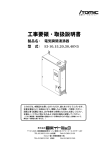
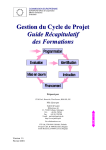
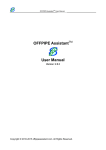
![[RELATIONS UNIVERSITE/ENTREPRISE : MODE D`EMPLOI]](http://vs1.manualzilla.com/store/data/006523986_1-75e95403c98b349c8633b197edb01d0a-150x150.png)
